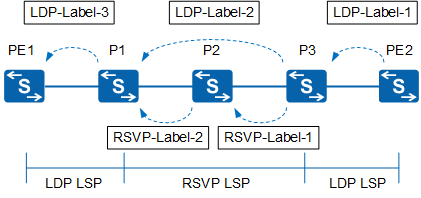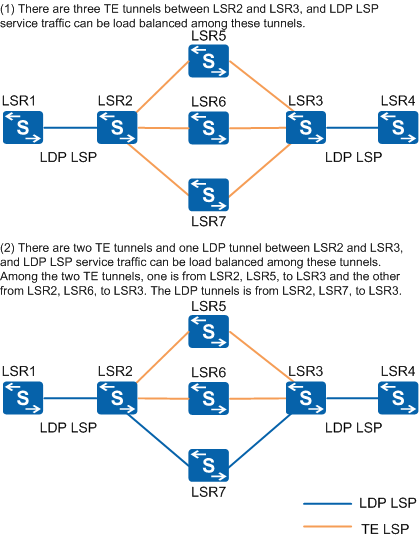LDP over TE
Overview of LDP over TE
MPLS TE supports strong traffic engineering capabilities and provides various QoS guarantees. Due to live network limitations, such as application types and costs, deploying MPLS TE on the entire network is difficult. Therefore, LDP over TE can be used to deploy MPLS TE on a core area and LDP on non-core areas.
RSVP-TE is an MPLS tunnel technique used to generate LSPs as tunnels for other protocols to transparently transmit packets. LDP is another MPLS tunnel technique also used to generate LDP LSPs. LDP over TE, a technique used by VPN, enables LDP LSPs to cross RSVP-TE areas.
After the RSVP-TE tunnel is established, an IGP (such as OSPF or IS-IS) enables the outbound interface of routes to select a TE tunnel through local calculation or by advertising link state advertisements (LSAs). The source device is directly connected to the destination device of the TE tunnel through the TE tunnel interface (logical interface). Actually, packets are transparently transmitted over the TE tunnel.
Process of setting up an LDP LSP over an RSVP-TE domain
As shown in Figure 1, P1, P2, and P3 belong to an RSVP-TE area. PE1 and PE2 are located in a VPN. LDP is run between PE1 and P1 and between P3 and PE2. Take the LDP LSP between PE1 and PE2 as an example to demonstrate the process of establishing an LDP LSP over the RSVP-TE domain.
- An RSVP-TE tunnel is set up between P1 and P3. P3 distributes RSVP-Label-1 to P2 and P2 assigns RSVP-Label-2 to P1.
- A remote LDP session is set up between P1 and P3.
- Traffic is imported to the RSVP TE tunnel. For example, forwarding adjacency is enabled on P1 and P3 to ensure that the outbound interface of the P1's route destined for PE2 is the tunnel interface.
- PE2 triggers LDP to set up an LSP and sends a Label Mapping message carrying LDP-Label-1 to P3.
- After receiving the Label Mapping message, P3 sends a Label Mapping message carrying LDP-Label-2 to P1 through the remote LDP session.
- After receiving the Label Mapping message, P1 sends a Label Mapping message carrying LDP-Label-3 to PE1.
The LDP LSP from PE1 to PE2 is set up over the RSVP-TE domain.
Typical Application of the LDP over TE
The LDP over TE mainly applies to a network where TE is supported only by devices at the core of the network rather than being supported by all devices on the network. That is, the TE tunnel serves as the "next hop" of the LDP LSP.

LDP over TE Load Balancing
In LDP over TE networking, switches support load balancing. When there are multiple TE tunnels or there are both TE tunnels and LDP tunnels in the MPLS TE domain, LDP LSP service traffic can be load balanced among multiple tunnels. In Figure 3, when LDP LSP service traffic passes through the MPLS TE domain between LSR2 and LSR3, the traffic can be load balanced among multiple tunnels.

